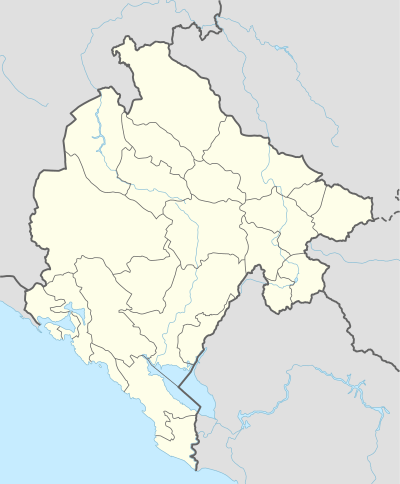Danilovgrad
Danilovgrad (Montenegrin and Serbian Cyrillic: Даниловград, pronounced [dǎnilɔv̞ɡraːd]) is a town in central Montenegro. It has a population of 6,852 (2011 census). It is situated in the Danilovgrad Municipality which lies along the main route between Montenegro's two largest cities, Podgorica and Nikšić. Via villages, Danilovgrad forms part of a conurbation with Podgorica.
Danilovgrad Даниловград | |
|---|---|
Town and municipality | |
 World War II monument in Town main square | |
 Coat of arms | |
 Danilovgrad Location of Danilovgrad in Montenegro | |
| Coordinates: 42.61°N 19.05°E | |
| Country | |
| Municipality | Danilovgrad Municipality |
| Settlements | 80 |
| Government | |
| • Mayor | Zorica Kovačević (DPS) |
| • Ruling party | DPS - SD |
| Area | |
| • Town and municipality | 501 km2 (193 sq mi) |
| Population (2011 census) | |
| • Density | 33/km2 (90/sq mi) |
| • Urban | 6,852 |
| • Rural | 11,620 |
| • Municipality | 18,472 |
| Time zone | UTC+1 (CET) |
| • Summer (DST) | UTC+2 (CEST) |
| Postal code | 81410 |
| Area code | +382 20 |
| ISO 3166-2 code | ME-07 |
| Car plates | DG |
| Climate | Cfa |
| Website | http://danilovgrad.me/ |
The town of Danilovgrad is located in the fertile valley of the Zeta River, sometimes called also the Bjelopavlići plain, after the name of the local clan. It is the centre of the Danilovgrad municipality, which has a population of 18,472.
History
In the place of Danilovgrad, there are remains of Gradina (Martinići), remains can be found of the ruler Petar Gojniković. The court was built by prince Mutimir, who was also once buried in there, also from the dynasty of Vlastimirović (Višeslavić). Gradina is also a prominent seat from the Nemanjić period, believed to be the birthplace of Prince Rastko, also known as Saint Sava, the founder of the Serbian Orthodox Church.
Danilovgrad was founded with the purpose of being the capital of Montenegro. Foundations for this planned city were first laid by King Nikola I in 1870. However, after the cities of Nikšić and Podgorica were liberated from Ottoman hands, during the Congress of Berlin its significance diminished. It got its name after Nicholas' predecessor Prince Danilo.
World War II
On May 31, 1944, a USAF Consolidated B-24 Liberator crashed in Danilovgrad.[1] Although its entire crew of 10 ejected and survived, they were later caught and became prisoners of war.[1] On July 23, 1944, 52 people, allegedly members of the League of Communist Youth of Yugoslavia,[2] were killed in a mass execution by Chetniks in Danilovgrad.[3]
During the Yugoslav Wars
On April 14-15, 1995, a pogrom drove out the Romani population in one of Danilovgrad's neighborhoods, Božova Glavica.[4]
On March 24, 1999, the Milovan Šaranović barracks in Danilovgrad were bombed by NATO aircraft, killing a soldier named Saša Stojić.[5] He was the first victim of the NATO bombing of Yugoslavia.[5]
Transport
Danilovgrad is situated approximately halfway between two largest Montenegrin cities, Podgorica and Nikšić, on the main road that connects these two. It is also served by the Nikšić–Podgorica railway.
Podgorica Airport is 30 km (19 mi) away, and has regular flights to Belgrade, Budapest, Bari, Zagreb, Skopje, Zürich, Frankfurt, Ljubljana, Paris, Rome and Vienna.
References
- Joe Baugher. "1942 USAAF Serial Numbers (42-50027 to 42-57212)".
- Hronologija narodnooslobodilačkog rata 1941-1945: Na Lazinama (kod Danilovgrada) četnici streljali 48 članova SKOJ-a (in Serbian). Accessed December 29, 2018.
- "POLOŽEN VIJENAC NA LAZINAMA" (PDF) (in Serbian). July 23, 2017. Retrieved December 29, 2018.
- "Slučaj Danilovgrad" (PDF). Swedish Helsinki Committee for Human Rights. 2004.
- Jelena Kulidžan (March 25, 2014). "Od bombardovanja do članstva u NATO". Deutsche Welle (in Serbian). Retrieved December 28, 2018.
External links
| Wikimedia Commons has media related to Danilovgrad. |